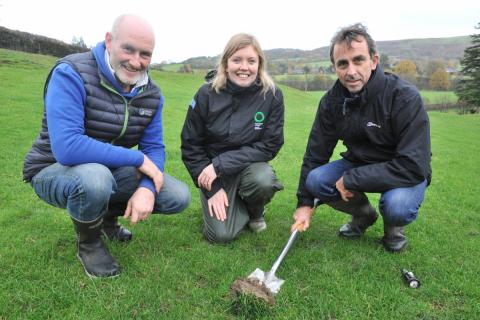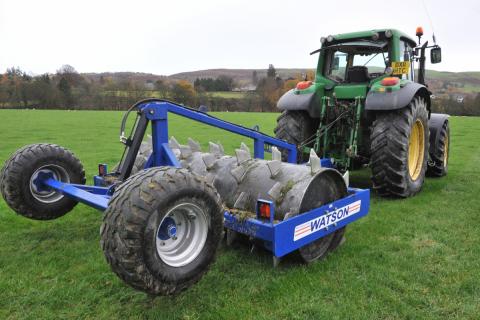30 November 2018
Increasing soil pH from 5.9 to a target of 6.3-6.5 will improve fertiliser utilisation on grassland farms by £120/hectare (ha), a soil specialist calculates.
Independent agronomist Mark Tripney, who analyses farmland soils, says when pH is less than 6, 48% of soil phosphate is unavailable to grass and crops.
“Farmers are wasting their money if they apply fertiliser at a sub-6 pH, not only will half the phosphate be locked up but 11% of nitrogen is lost too,’’ he told farmers attending an open day at Llysun, a Farming Connect Demonstration Farm near Welshpool.
“At today’s prices, this is costing them £120/ha and reducing grass yields.’’
In Wales, farmers registered with Farming Connect are eligible for 80% funding for soil sampling.
Of the 4,000 Welsh farms whose soils were analysed through Farming Connect last year, only 30% were at pH 6 or higher.
Lifting pH is not a quick fix – applying 1t/ha of lime will only raise the index by 0.2 – but Mr Tripney urges farmers to take action.
As lime quality can be variable, he advises farmers to ask for the product specification before they buy, and to not buy purely on price.
“A lot of lime doesn’t meet the standard required by the 1991 Fertiliser Regulations so it is important to only buy a product that carries the Agricultural Lime Association’s AQS quality standard,’’ says Mr Tripney.
Not only should soil be tested for pH, phosphorous, potassium and magnesium but also for calcium and sodium because they influence soil pH and structure.
At Llysun, an 800-acre upland farm, livestock farmer Richard Tudor has used the results of a detailed analysis to make changes.
The test showed a deficiency of boron, a mineral which helps to transport calcium to the grass plant and improves its digestibility.
To rectify the shortfall, Mr Tudor applied 0.75kg/ha of boron with fertiliser this year and this has nearly doubled boron levels in grass; in fields where the bornonated fertiliser was applied, boron levels went from low to normal – in one field levels rose from 5.64 milligram/litre to 11.8 mg/l.
Soils at Llysun have an average pH of 5.9 and is a reason why the farm is not producing its 10t DM/ha potential, says Mr Tudor.
Lime is now applied to 20% of the farm annually, with the aim of raising pH nearer to 6.5.
The potential cost benefit is significant. “Research has clearly shown that for every £100 we spend on lime there is a benefit of up to £700,’’ says Mr Tudor, a Nuffield Scholar who studied the health and fertility of grassland soils.
He is also addressing compaction in his clay loam soils – he reckons compaction has reduced performance by up to 40% in some fields
“Compaction is a slow burner, you don’t realise there is a problem until it is acute, when you are not getting the performance from your fields that you once had,’’ says Mr Tudor.
“We needed to get the soil working properly, to get some air down into the roots and to give those roots the environment in which to make better use of nutrients.’’
His main focus has been silage fields, where heavy machinery had caused compaction.
Holes dug in those fields revealed a compacted layer beneath the first few inches of surface soil which had caused waterlogging.
This summer Mr Tudor invested in a ballast aerator and aerated 30% of his farm.
He doesn’t expect instant results but says: “Aerated fields show better root penetration and less compaction.
“The grass roots can now go down further and that can only be beneficial.’’
Mr Tudor aerated in late spring, when ground conditions were dry.
“Although I have never baked a cake I have been advised that the approach used to test a cake to see if it is cooked is similar to that for checking the soil.
“If you insert a skewer into a cake it will come out clean when the cake is baked, it won’t be sticky.
“The same is true if you poke a blade or spade into the soil, if soil sticks to it the ground is not ready to be aerated.’’
He used a soil slitter to deal with deeper compaction on recently purchased land.
Mr Tudor is converting his farm from a beef and sheep enterprise to dairy – he aims to start milking in April 2020.
Although his approach to farming has always been to make the best use of grazed grass, his conversion plans have focused his mind on improving forage utilisation.
“With our grassland management, the farm conversion is taking things to the next level, it is all about marginal gains.
“If you look at the Wales Farm Business Survey, the top third of producers in every sector have the highest stocking rates, it is a big driver for profitability, and that is where we want to be.’’


